To address its enterprise information management (EIM) capabilities, SAP has a complete set of products that will take a customer through all stages of an EIM journey. This post will look at the functionality of several key EIM offerings.
SAP Data Services
SAP Data Services is a powerful tool that enables organizations to understand and profile their level of data quality, to integrate their data across the enterprise, and to improve and correct issues with this enterprise data.
Extract, transform, and load (ETL) capabilities are important features of the solution, which allow a company to take data from any data source and then ensure a high level of data quality by applying rules, transformations, and filters before loading the data into the required target databases, applications, or business warehouses. These data sources include both big data and cloud sources. Today, SAP Data Services supports many of the most popular big data systems, including Hadoop, SAP HANA, HPE Vertica, NoSQL MongoDB, Google BigQuery, Azure SQL Database, and Amazon Redshift.
All of these data-quality capabilities can be applied to incoming data and can be integrated with your enterprise systems for ensuring high levels of data quality at the point of entry.
Text data processing capabilities are also included, deriving meaning and insight from natural language processing on unstructured text sources, such as Word and PDF documents, as well as other text sources.
A graphic of the most important capabilities of the SAP Data Services solution is shown in the figure below. These capabilities include the following:
- Access and extract structured and unstructured data—SAP and non-SAP—in batches or in real time.
- Transform, cleanse, match, and consolidate data.
- Scale from single to multiple servers for all volumes of data.
- Support a wide variety of SAP and non-SAP targets.
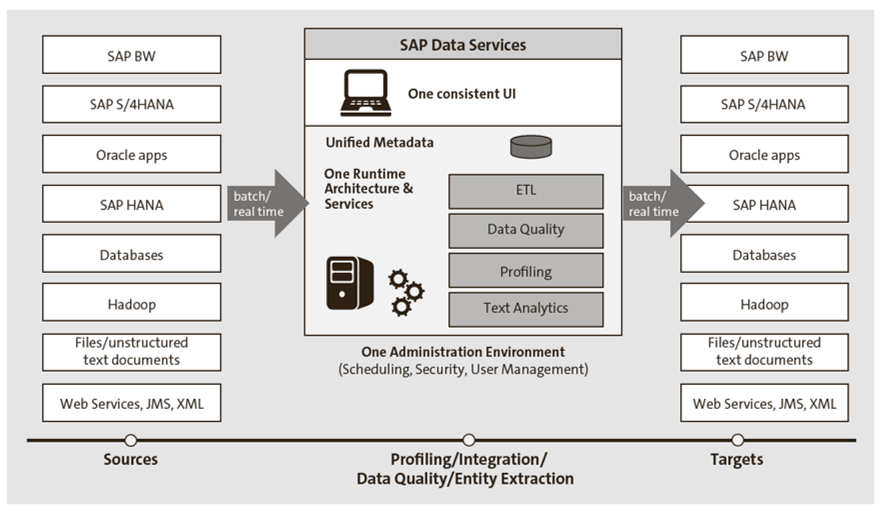
SAP Information Steward
SAP Information Steward takes the power of SAP Data Services and places it in the hands of the business users whose job is to ensure that a high level of data quality is maintained across the enterprise.
The main capabilities of the solution include the ability to profile and monitor data quality across the enterprise; allow key data stakeholders to manage and understand metadata and data lineage across complex landscapes; define business rules, terms, and policies governing data; enhance operational, analytical, and data governance initiatives; and enable collaboration across important roles in a data organization. All of this is achieved through a business-friendly UI incorporating powerful dashboards and scorecards, along with event-driven notifications when thresholds aren’t being met.
A graphic of the top capabilities of the SAP Information Steward solution is shown below. These capabilities include the following:
- Discover the business glossary and metadata. Formally develop information policies.
- Define business terms, validation rules, and cleansing rules using profiling results.
- Enable workflow for data quality task ownership of data assets.
- Monitor and resolve data quality issues with preloaded templates.
- Analyze data quality using business value analysis to quantify financial impact.
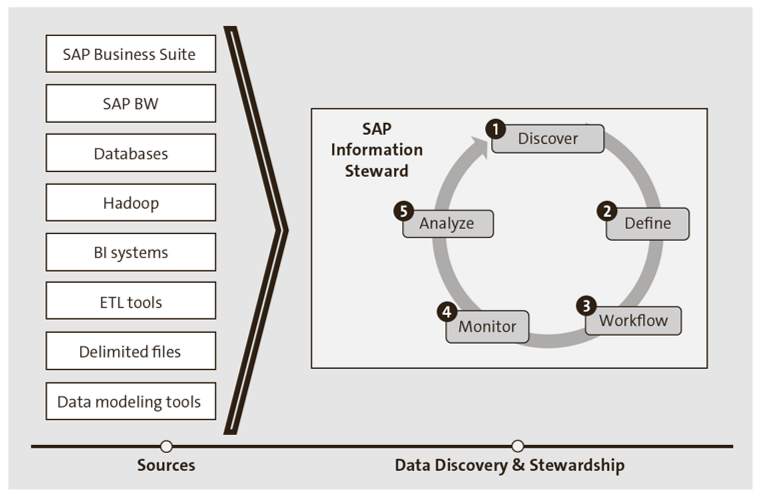
SAP HANA Smart Data Integration and SAP HANA Smart Data Quality
SAP is investing in EIM solutions built natively in the SAP HANA platform. The SAP HANA smart data integration and SAP HANA smart data quality solutions are the foundations of these developments, delivering data integration, data replication, and data quality capabilities to the enterprise.
These solutions allow batch or real-time data replication by applying filters, transformations, and data quality rules as needed across a landscape. Data profiling and data enrichment capabilities are also key use cases.
Along with these benefits comes the ability to develop applications on top of this powerful framework. Some example applications that use these features with the EIM portfolio are SAP Master Data Governance and SAP Agile Data Preparation.
A summary of the main features of SAP HANA smart data quality and SAP HANA smart data integration is provided in this figure.
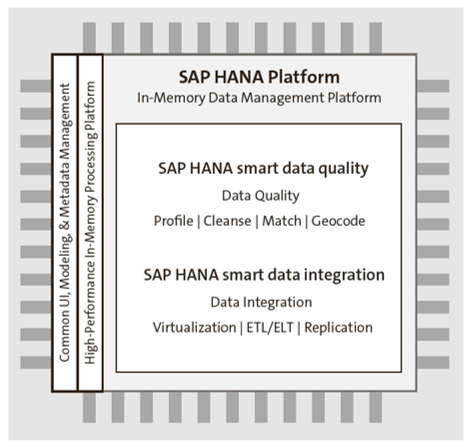
SAP Agile Data Preparation
A key market driver in the EIM space is the need for providing tools to allow for self-service data preparation. SAP Agile Data Preparation uses the power of SAP HANA to facilitate self-service data discovery, collaboration, and data preparation, improving both the quality and value of the master data in an enterprise. Organizational benefits will be realized through this trusted data for analytical use cases as well as improving the day-to-day operations of a business.
SAP Agile Data Preparation can be used by different groups within an enterprise, including business users, data stewards, data scientists, and those in the IT department. Business analysts will have the necessary access to a wide variety of data sources across the entire business landscape, allowing for greater visibility into critical enterprise information. IT groups will benefit through the self-service of business users and by allowing for greater control over data standards and security.
The following features and use cases of SAP Agile Data Preparation are noted in the next figure:
- Ingest data from a variety of sources.
- Use for profile data.
- Combine, shape, enrich, or cleanse data.
- Output data for downstream uses.
- Analyze and optimize user processes (IT governance team).
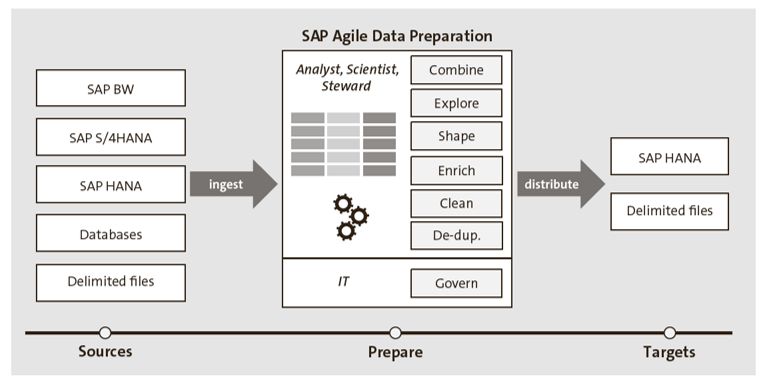
SAP Information Lifecycle Management
When data in an organization reaches the end of its retention period or a system in a landscape is ready to be retired, SAP Information Lifecycle Management (SAP ILM), as depicted in the next figure, will play a critical part in ensuring compliance by following all necessary legal regulations and organizational policies.
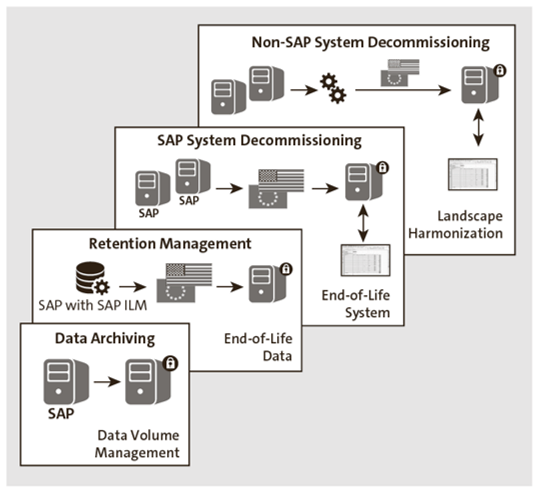
Furthermore, data archiving is a key capability of SAP ILM, allowing for data that is no longer needed to support the day-to-day operation of the business to be retired to cheaper, long-term storage.
Retention management is a critical topic that needs to be considered by all organizations to remain compliant in an increasingly complex regulatory environment. Data privacy regulations, such as the EU’s GDPR, apply strict standards regarding treatment of personal information. SAP ILM facilitates the definition of policies that will ensure enterprise data is blocked from destruction prior to the appropriate expiration date being reached and will manage the destruction of data after a retention period has been met and the data serves no further business value. SAP ILM is the tool to ensure that personal/sensitive information is blocked when archived. Finally, SAP ILM enables the organization to apply a legal hold on data that would need to be retained throughout a litigation process, for example.
Legacy system decommissioning is another important SAP ILM feature, facilitating the shutting down of any obsolete systems in a landscape and managing the retention rules that need to be applied to any data in those systems. As organizations are moving toward a digital enterprise, the need to shut down legacy systems is only going to increase.
SAP Content Management Solutions by OpenText
Another key component of a successful EIM strategy is ensuring that all the unstructured content in an enterprise is managed, governed, and handled in a cost-effective, efficient, and compliant fashion. Consider how many documents, spreadsheets, PDFs, emails, images, videos, and manuals exist in an enterprise. It’s vitally important for an organization to ensure that these documents are managed, accessed, and associated with the key enterprise data and processes that relate to them. As organizations move toward a digital core, the need to manage these documents in a controlled fashion is becoming more compelling.
Being able to manage and process all inbound and outbound communication (e.g., invoices, sales orders, purchase orders, delivery notifications, etc.) and internal documents (e.g., policy documents, employee files, technical drawings, maintenance schedules, etc.) as needed is critical to any enterprise. The SAP content management portfolio from OpenText allows organizations to get out from under a mountain of paper and to digitize their enterprise filing cabinet, provides significant process simplification and organizational benefits, and places this digital content at the fingertips of those who need it, where they need it, and when they need it.
Different solution providers are in this market area, but SAP content management solutions are different because they are SAP Solution Extensions, integrating natively with SAP software. This deep content association allows for true enterprise collaboration across both structured master data and unstructured enterprise content. In fact, SAP Extended Enterprise Content Management (SAP Extended ECM) by OpenText can be integrated with SAP Master Data Governance, allowing for the governance and control of both enterprise master data and unstructured content within one governance process.
The following key solutions are part of the SAP content management portfolio:
- SAP Extended ECM (as mentioned previously)
- SAP Archiving and Document Access by OpenText
- SAP Invoice Management by OpenText
- SAP Digital Content Processing by OpenText
- SAP Document Presentment by OpenText
The final figure demonstrates how content management capabilities can be made a part of and enhance an EIM strategy.
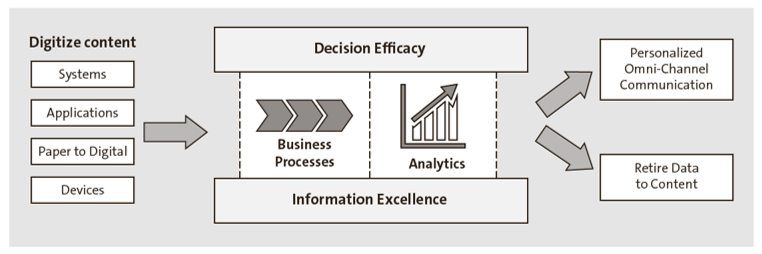
SAP LT Replication Server
SAP Landscape Transformation Replication Server (SLT) is a comprehensive data replication tool designed to facilitate the real-time transfer of data between different systems within an SAP landscape. Learn more about SLT here.
Editor’s note: This post has been adapted from a section of the book SAP Master Data Governance: The Comprehensive Guide by Bikram Dogra, Antony Isacc, Homiar Kalwachwala, Dilip Radhakrishnan, Syama Srinivasan, Sandeep Chahal, Santhosh Cheekoti, Rajani Khambhampati, Vikas Lodha, and David Quirk.
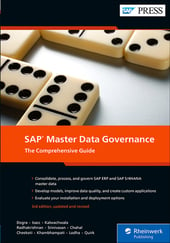


Comments